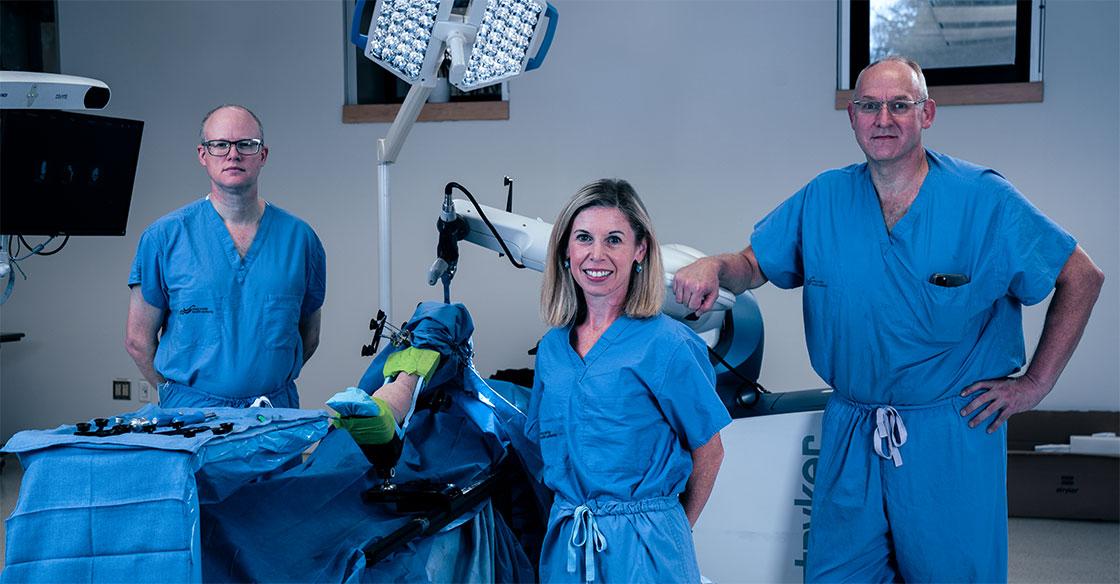
Originally published on qe2times.ca.
If you ask Dr. Michael Dunbar, the conversations medical professionals are having today about surgical robotics are not unlike the conversations pilots had 50 to 60 years ago, when aviation shifted from a craft that relied solely on the skill of the pilot to one including computer automation.
“And just like every pilot now can fly the aircraft without the computers, they’re better off having the computers assist them because it probably reduces the error rate longer term,” says Dr. Dunbar.
If we apply that logic to surgery, and think of a robot supporting the surgeon, we can imagine how that kind of automation and precision could improve outcomes.
“But that needs to be proven, definitively. We have a major role in Halifax — within Canada and internationally — to be part of that equation,” he says.
Dr. Dunbar, an orthopaedic surgeon at the QEII Health Sciences Centre, is considered a thought leader in his field. He specializes in arthroplasty, or joint replacement surgery, of the hip and knees.
It was the highlight of his career in September 2021 when the QEII became the second hospital in Canada to acquire an orthopaedic surgical robot. The technology is in high demand across the country. Nova Scotia Health’s Innovation team has been working closely with the industry partner for over a year to secure the opportunity to receive a robot and begin conducting research that will have international reach.
The QEII Foundation has committed to raising $2.5 million to fund the technology and the research.
At Dr. Dunbar’s side are Dr. Glen Richardson, fellow orthopaedic surgeon at the QEII and Dr. Janie Wilson, PhD, who has researched collaboratively as a biomedical engineer with Drs. Dunbar and Richardson for decades. Dr. Wilson was also recently recruited back as director of the School of Biomedical Engineering at Dalhousie University.
Together, these experts are at the forefront of their fields, recognized internationally for their research.
“And we are just the tip of the scalpel,” says Dr. Dunbar.
What Dr. Dunbar means is that it takes a big team of health administrators, residents, fellows, masters and PhD students to do the research to bring this project to life. And, contextually, we’re in the right environment at the QEII, a teaching hospital lockstep with Dalhousie University, and supported by Nova Scotia Health’s research team. We have the infrastructure and the history of research to support this work.
“Without donor support, it just wouldn’t happen,” says Dr. Richardson.
“Donors who support robotic surgery are giving us the opportunity to bring very advanced technology to Nova Scotians, something that we would never have access to otherwise.”
- Dr. Glen Richardson
Traditional knee and hip surgeries are based on 2D-imaging and rely fully on the skill and craft of the surgeon. Cuts are based on the average person.
“We just have to look around to see that it’s obvious that we’re all slightly different — the way we look, the way we walk,” says Dr. Dunbar. “With the robot, for the first time, we’re able to look and investigate and say that your skeleton is actually slightly differently shaped than my skeleton, versus another patient’s. And previously, we might have been aware of that, but we weren’t able to impute that into a surgical plan and say, ‘what am I going to do differently?’”
The robot allows the surgeon to use 3D-imaging to plan the exact placement of an implant within the skeleton.
“My hope is that robotic surgeries will allow us to take individual patients and perform an operation that’s specific to them and know beforehand that we’re going to be able to get the best-possible result,” says Dr. Richardson.
This is the true intent of Nova Scotia Health’s innovation team.
“We look for ways to support clinicians to be able to provide quality care using the latest technology in the market, paired with a research program to continually support learning,” says Brittney MacKinnon, Director of Innovation with Nova Scotia Health.
Dr. Janie Wilson says the robot is, “the missing piece that now allows us to do the type of research that we would really like to do to help Nova Scotians.”
“We’ve been running research studies for years that have combined things like instrumented gait analysis — where we can monitor the three-dimensional movement and forces on a person’s joints as they move — with precise implant imaging and data modelling,” she says.
“We’ve developed an ecosystem that brings biomedical technology and clinical studies together to understand particular aspects of patient outcomes that aren’t possible without that technology. The robotic technology will now allow us to leverage the knowledge we’ve developed from years of research, by allowing us to develop and validate precise surgical plans that are specific to the needs, the anatomy and the function of the individual patient.”
The QEII teams have also worked with Radiostereometric Analysis (RSA), a technology that monitors an implant, as well as how it moves, within the bone after surgery.
All of these pieces fit together to create a centre of excellence at Nova Scotia Health, meaning that the QEII can finally have its moment as a true leader in orthopaedic care.
If you or a loved one are on a knee or hip surgery list, don’t fret — you will still receive top-notch care today at the QEII.
“Knee and hip replacement surgery are some of the best surgeries ever developed and are remarkable in terms of how far we’ve come with the technology,” Dr. Dunbar says. “And what we’re talking about now is breaking through a glass ceiling and going to the next level.”
For more about the QEII’s surgical orthopaedic robot, visit QE2Foundation.ca/orthorobot.
Nova Scotia Health’s Research, Innovation and Discovery portfolio is leading the transformation of health care delivery to improve the health of all Nova Scotians with innovation initiatives that deliver high-impact health care solutions through strategic partnerships with clinical champions, industry, healthcare foundations, governments and academic partners.